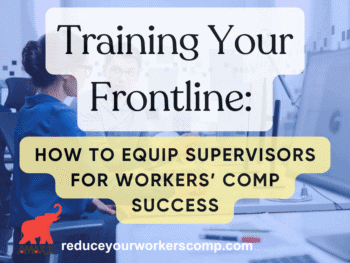
It All Starts with Injury Prevention
Injury prevention should be at the cornerstone of every accident investigation program. This is done by asking the “reporter questions” – who, what, when, where, how, and why – post-injury. These questions are asked to discover what happened and, more importantly, why. The “why” question, in particular, allows those reviewing the mechanism of the injury to determine trends and make corrections.
The proper collection of data is vital. Using an electronic reporting form reduces the chances of errors and leads to consistency in the information collected. Now is the time to change from paper forms to an electronic reporting system.
Click Link to Access Free PDF Download
“The 5Cs to Taking a Bulletproof Injured Worker Recorded Statement”
Education and Training Are a Must
Another essential piece of the puzzle includes having the proper training and instruction within the workplace. This is because safety practices for one industry might not necessarily fit within others. Information that needs to be communicated includes:
- The emphasis that safety requires 100% participation from 100% of employees;
- How to safely perform each position or job function within the workplace; and
- What safety equipment such as eye protection, covering, certain types of footwear, etc., is required.
All supervisors and managers must practice what they preach regardless of title or service length. Workplace safety will never result if there is no buy-in and action.
Supplying the Right Type of Safety Equipment
Employers and other interested stakeholders must also provide the proper safety equipment for their workplace. There is also the need for the designated safety coordinator to take an inventory of the workplace environment and ensure proper signage and training are provided, so employees use the safety equipment correctly. Examples of steps that can be taken include:
- Post signs at the entrance of a work location as to what safety equipment needs to be worn. Common considerations include eye protection, ear protection, ventilators and masks, and proper footwear;
- Solicit feedback from employees on how safety equipment is distributed and what additional equipment might be needed; and
- Reinforce safety policies and procedures regularly.
All safety instructions and signs should be provided in languages commonly used within the workplace. Never assume everyone speaks and reads English. Obtaining posters in other common languages such as Spanish, Somali, and other languages is easy. Include pictures of standard safety practices to reinforce correct procedures and conduct.
Include Incentives to Drive Safety in the Workplace
When putting together the safety puzzle, it is vital to drive safety through incentives. These incentives can be both financial and non-monetary. Remember, you can never buy safety.
- Include feedback from all employees on an incentive program;
- Set achievable safety benchmarks that are realistic;
- Evaluate a program to ensure the incidents and “near misses” are not being reported; and
- Differentiate the difference an individual is making compared to an entire group.
The timely reporting of work injuries is an important metric to consider as part of these programs. It recognizes that injuries occur and rewards behavior that benefits claim investigation. Interested stakeholders should also consider alternatives such as missing pieces to the puzzle, such as potlucks, pizza parties, and recreational events as part of a program. Make it fun that drives home the goal – a safer work environment.
Benefits of an Accident Investigation Program
An effective accident investigation program has many benefits beyond reducing workers’ compensation program costs. These benefits can help reduce workplace injuries before they occur. This can be driven by data that is easy to collect and track. Consider using a safety committee to record and disseminate the information.
Conclusions
Putting together a puzzle takes time and concentration. When working hard to create a safer workplace, everyone should consider the many safety puzzle pieces. It can include injury prevention, education and training, providing the right equipment, and driving behavior through incentives that work. When done, everyone will succeed in making the workplace safer and reaching the required result with a better workers’ compensation program.

Contact: mstack@reduceyourworkerscomp.com.
Workers’ Comp Roundup Blog: http://blog.reduceyourworkerscomp.com/
©2022 Amaxx LLC. All rights reserved under International Copyright Law.
Do not use this information without independent verification. All state laws vary. You should consult with your insurance broker, attorney, or qualified professional.

















